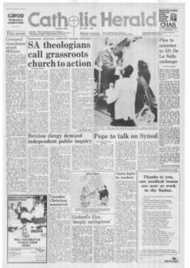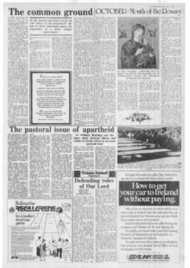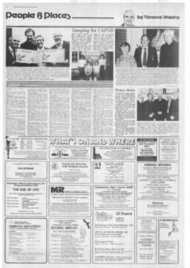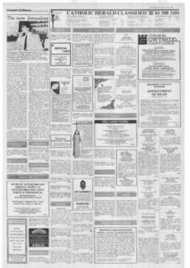Page 7, 4th October 1985
Page 7

Report an error
Noticed an error on this page?If you've noticed an error in this article please click here to report it.
Tags
Share
Related articles
Obituary
A Brilliant Biography Of Nelson
The Art Of Depicting Holiness
Patrick O'donovan On Dave Allen Jokes Or Jibes?
Raising Moral Questions About Youth
Mastering the Masters
Paul Delaney reports on a remarkable Catholic artist George Warner Allen
GEORGE Warner Allen was a Catholic artist long before he himself became a Catholic. Ever since he was a boy and fell in love with Italian Renaissance painting, he has wanted to paint religious pictures. Michelangelo was his first great inspiration, and Titian has been the great influence on his work.
When he was 20, he first thought of painting the Stations of the Cross, a challenge which was taken up by surprisingly few — only Tiepolo — among the Old Masters. It took 40 years before he felt ready, to try to realise this ambition.
At the age of 17 he went from Lancing College to the Byam Shaw School of Art which had been recommended to him by the artist Robert Anning Bell, RA, and the art critic James Greig.
Under the leadership of Ernest Jackson, ARA, one of the best teachers of drawing of the human form of his generation, this school achieved considerable artistic success in the 30s, with two students winning the coveted Prix de Rome and other prizes.
During his six years there, Warner Allen already felt the conflict between his own artistic interests and those of the time. While he wanted to paint figure subjects in the tradition of centuries of European art, the drift of the period was towards modernism, towards free expressive drawing, highly personal interpretations of nature, abstract art. These had absolutely no appeal to him.
What fascinated him was the way the Old Masters achieved the effects in their paintings, so he began studying and experimenting with their techniques. In this he was aided by his experience as a camouflage officer during the second World War, where working with scientists taught him a great deal about scientific analysis.
He experimented with such materials, not used today, as Lapis Lazuli, verdegris, Egyptian Mummy, lead tin Yellow, as well as combining tempera and oil painting in the same picture. Few practising artists today have his understanding both practical and theoretical, of the way the Old Masters painted.
In 1952, a large one-man show of his work was held at the Walker Galleries, New Bond St, London and later at the Reading Art Gallery. It included religious pictures like the magnificent Martha and Mary, lovely pastoral scenes inspired by the poetry of Matthew Arnold and George Meredith, and The Dead Airman, a moving war memorial of a fallen airman, lying on a meadow spangled with flowers, with wild animals around him.
This work and another were acquired by the Nuffield Foundation. Among those who purchased works at the Exhibition were the poets T S Eliot and Sir John Betjeman, the Earl Baldwin, the Reading and Nottingham Art Galleries. More than half the pictures were sold and the shows were widely reviewed.
Ironically, the strain of preparing this successful exhibition told on the artist afterwards. He had hoped to go on and do altarpieces for churches, but found himself unable to paint for the next eight years. Such an experience, a sort of painter's block, is a dark night of the soul for an artist. He kept on teaching at the Byam Shaw School for a while but eventually gave this up too and devoted himself to the care of his elderly parents. It was a happy day when inspiration and his painting returned.
It always puzzled his friends that although not a Catholic, he prefered to paint such Catholic subjects as Crucifixions, Depositions and Holy Families. One of the last pictures he had completed before his painting block was a painting of Christ appearing to wayside picnickers against a distant view of the factories of Wolverhampton, commissioned for an Anglican church in that city (now at Communicarc House, Killingworth Township, Newcastle-upon-Tyne).
One of the first pictures he did after the eight-year break was a large altarpiece intended as a War Memorial with side panels representing branches of the armed forces that took part in the war.
When a Catholic friend suggested that he might paint a tribute to Cardinal Newman, a figure who has long fascinated Warner Allen, he realised that he could only paint it if he became a Catholic. Up to then, he had hesitated to take that step due to family disapproval, though he had long abandoned the Anglicanism of his childhood.
He was instructed and received into the Church by Canon Crozier at Abingdon in 1973. Along with The Oratorian ,4Itarpiece, depicting Our Lady, the Christ Child, Cardinal Newman and St Philip Neri, he has since completed two portraits of the Cardinal, who in his Anglican days had been a friend of his great-grandfather, Canon John Manuel Echalaz. It was a great thrill to discover a letter from Echalaz to Newman in the archives of the Birmingham Oratory.
In 1980 he had reached a point where he could take up his early ambition to paint the Stations of the Cross. In these he feels the key is clear and simple design, so that they can be immediately understood by anyone making the Stations. Imaginative design is the quality he most strives for in his painting, and a dramatic touch is added here by having the sky gradually get darker and more stormy as the story unfolds.
This echoes a line in Dante's Divine Comedy: "I thought the universe must feel the power of love'. The various stages of painting in his medium of mixed oil and tempera, which he grinds himself, has meant that after five years the series is now almost finished. Painting is always for George Warner Allen Ad Majorem Dei Gloriam and never more so than in the Story of the Passion, the greatest subject possible in art.
George Warner Allen lives at [den House, Brightwell-cumSotwell, nr Wallingford, Oxon.
blog comments powered by Disqus











